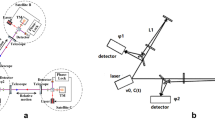The possibility of determining the difference in gravitational potentials and orthometric heights in the Earth’s field based on measurements of the phase difference of laser radiation in an optical fiber is proposed and investigated in this study. Such a phase difference is attributed to the effect of the gravitational delay of light waves. A block diagram of a measuring complex designed to measure the phase difference of light waves caused by this effect is proposed. The measurements use two coherent light waves from a single laser, each propagating along a separate fiber-optic communication line. The composition of each fiber-optic communication line includes the same coils of a long optical fiber, spaced apart in height. The analysis of the factors influencing the phase relations of waves propagating along two communication lines of the measuring complex is performed. The phase effects of the delay, caused by the influence of the true gravitational field of the Earth, and the influence of the fields of inertial forces and gyroscopic effects due to the Earth’s rotation are determined. Methods for suppressing interfering effects are proposed. The achievable errors in measuring the differences in gravitational potentials and corresponding orthometric heights are estimated. With a fiber length in coils of 100 km and a height difference of 100 m, the errors are 0.2 m2/s2 and 2 cm, respectively. The measuring complex under study is called a laser gravipotentiometer. It is an optical analog of the well-known radio-frequency quantum-level unit, but it does not require ultrastable frequency and time standards. The research results of the proposed measuring complex are relevant for the development and improvement of measuring instruments for the parameters of the Earth’s gravitational field and a means of the high-precision synchronization of time scales of remote standards.


Similar content being viewed by others
Notes
Optical phase shifters. URL: https://sphotonics.ru/catalog/photonic-time-delays (reference date: 05/25/2022)
References
V. F. Fateev, A. I. Zharikov, V. P. Sysoev, E. A. Rybakov, and F. R. Smirnov, On measuring the difference in the Earth's gravitational potentials using transportable quantum clocks, Dokl. Akad. Nauk, 472, No. 2, 206–209 (2017), https://doi.org/10.7868/S0869565217020189.
V. F. Fateev, F. R. Smirnov, and S. S. Donchenko, Measuring the effect of gravitational time dilation with a duplex ground-based quantum level unit, Izmerit. Tekh., No. 2, 22–27 (2022), https://doi.org/10.32446/0368-1025it.2022-2-22-27.
J. Muller, D. Dirkx, S. M. Kopeikin, G. Lion, I. Panet, G. Petit, and P. N. A. M. Visser, Space Sci. Rev., 214, No. 5 (2018), https://doi.org/10.1007/s11214-017-0431-z.
L. D. Landau and E. M. Lifshits, Field Theory, Nauka, Moscow (1967).
V. A. Fok, Theory of Space, Time and Gravity, Fizmatgiz, Moscow (1961).
I. I. Shapiro, Fourth test of general relativity, Phys. Rev. Lett., 13, 789–790 (1964).
S. G. Turyshev, Experimental verifications of the general theory of relativity: Recent progress and future directions of research, Usp. Fiz. Nauk, 179, No. 1, 3–34 (2009), https://doi.org/10.3367/UFNr.0179.200901a.0003.
I. I. Shapiro, R. D. Reasenberg, P. E. MacNeil, R. B. Goldstein, J. P. Brenkle, D. L. Cain, T. Komarek, A. I. Zygielbaum, W. F. Cuddihy, and W. H. Michael Jr., J. Geophys. Res., 82, No. 28, 4329–4334 (1977), 10.1029/ JS082i028p04329.
I. I. Shapiro, Ch. C. Counselman, III, and R. W. King, Phys. Rev. Lett., 36, No. 11, 555–558 (1976), https://doi.org/10.1103/PhysRevLett.36.555.
J. G. Williams, S. G. Turyshev, and D. H. Boggs, Int. J. Mod. Phys. D, 18, No. 07, 1129–1175 (2009), https://doi.org/10.1142/S021827180901500X.
B. Bertotti, L. Iess, and P. Tortora, Nature, 425, 374–376 (2003), https://doi.org/10.1038/nature01997.
V. F. Fateev, Relativistic Metrology of Near-Earth Space-Time, Monograph, FGUP VNIIFTRI, Mendeleevo (2017).
V. F. Fateev, Refractive properties of gravitational sphere of the Earth in the rotating coordinate systems, Elektromagnit. Volny Elektron. Sist., 18, No. 5, 73–82 (2013).
O. V. Kolmogorov, D. V. Prokhorov, and S. S. Donchenko, Results of development and research of systems for comparison and synchronization of time scales of spatially remote standards using fiber-optic communication lines, Foton-Ekspress, No. 6(158), 83–84 (2019), https://doi.org/10.24411/2308-6920-2019-16038.
Author information
Authors and Affiliations
Corresponding author
Additional information
Translated from Izmeritel'naya Tekhnika, No. 9, pp. 33–39, September, 2022.
Rights and permissions
Springer Nature or its licensor (e.g. a society or other partner) holds exclusive rights to this article under a publishing agreement with the author(s) or other rightsholder(s); author self-archiving of the accepted manuscript version of this article is solely governed by the terms of such publishing agreement and applicable law.
About this article
Cite this article
Fateev, V.F., Kolmogorov, O.V. Determination of the Gravitational Potential Difference in the Earth’s Field Based on the Measurement of the Gravitational Delay of Light Waves in an Optical Fiber. Meas Tech 65, 652–659 (2022). https://doi.org/10.1007/s11018-023-02135-7
Received:
Accepted:
Published:
Issue Date:
DOI: https://doi.org/10.1007/s11018-023-02135-7




